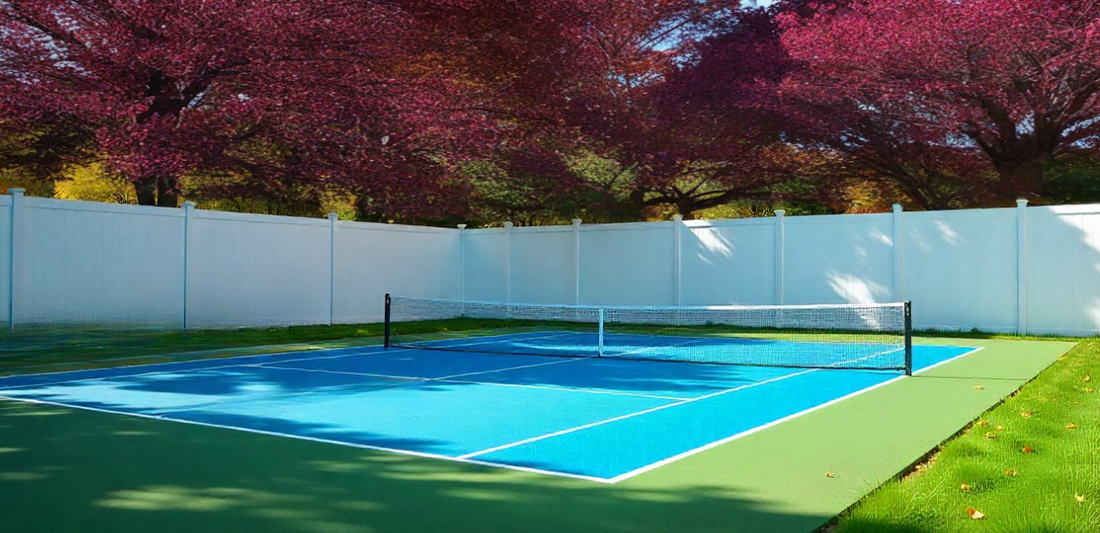Pickleball has taken the sports world by storm, captivating enthusiasts of all ages with its unique blend of tennis, badminton, and table tennis. As its popularity continues to grow, many homeowners are looking to bring the excitement of this fast-paced game right to their backyards. Installing a pickleball court at home not only provides a convenient space for recreation but also has an impact on property value and overall lifestyle. As one of the fastest-growing racquet sports in recent years, pickleball offers a fun and accessible way to stay active.
This article aims to guide readers through the process of transforming their backyard into a pickleball paradise. It covers the basics of pickleball court dimensions, explores various surface options, and discusses the steps to prepare the area for construction. Additionally, readers will learn about essential equipment like portable pickleball nets and discover tips to add finishing touches that make their court stand out. By the end, homeowners will have the knowledge to create a regulation pickleball court that rivals any indoor facility.
Understanding Pickleball Court Basics

Court Dimensions
Pickleball courts have specific dimensions that players need to be familiar with. The standard pickleball court measures 44 feet long and 20 feet wide, including the lines. This rectangular playing area provides ample space for players to move around safely, with a total square footage of 880 square feet. To ensure player safety during rallies, it's recommended to have an additional clear space of 10 feet at each end of the court and 5 feet on each side, free from any obstacles.
Net Height Requirements
The pickleball net has unique height requirements that differ slightly from other racquet sports. According to USA Pickleball regulations, the net should be 34 inches high at the center and 36 inches high at the sidelines. This slight difference in height creates a subtle slope across the net. The net's length should extend at least 21 feet 9 inches from one post to the other, ensuring it covers the entire width of the court with a slight overhang on each side.
Non-Volley Zone (Kitchen) Specifications
A distinctive feature of pickleball is the Non-Volley Zone, commonly referred to as "the kitchen." This area extends 7 feet on either side of the net and spans the full width of the court. The kitchen plays a crucial role in gameplay strategy, as players are not allowed to volley (hit the ball without letting it bounce) while standing in this zone. This rule encourages a variety of shots and tactics, such as dinks and drop shots, which are integral to the finesse and strategic aspects of pickleball. The kitchen also enhances safety by preventing overly aggressive net play that could lead to collisions or injuries.
For a comprehensive overview of the game's regulations, check out this detailed guide on Pickleball Rules.
Cost Considerations
Before beginning your backyard pickleball court project, it's important to understand the investment required. Professional court installation typically ranges from $16 to $27 per square foot. However, choosing a DIY approach can significantly reduce these costs while still achieving excellent results. This cost variation allows homeowners to choose an approach that best fits their budget while still creating a quality playing surface.
Preparing Your Backyard for a Pickleball Court

Site Selection
Choosing the right location for a backyard pickleball court is crucial for its success. Homeowners should consider several factors when selecting the ideal spot:
-
Orientation: Position the court north-south to minimize glare during early mornings and evenings.
- Space: Ensure the area accommodates the court dimensions (44’x20’) plus 5–10 feet of clear space on all sides.
Clearing and Leveling the Area
Once the location is chosen, the next step is to prepare the site:
- Remove vegetation, rocks, and debris.
- Excavate to a depth of at least 12 inches for a stable foundation.
- Level the surface meticulously—a slight slope (1%–0.83%) in one direction aids drainage.
Drainage Considerations
Proper drainage is vital for maintaining the court’s longevity:
- Install a French drain system around the court’s edges.
- Ensure the slope directs rainwater away from the playing surface.
Choosing the Right Court Surface

When selecting a surface for a backyard pickleball court, homeowners have several options to consider. Each surface type has its own set of advantages and drawbacks, affecting factors such as playability, maintenance, and cost.
Concrete vs. Asphalt
Concrete and asphalt are two popular choices for pickleball court surfaces. Concrete courts are known for their durability and consistent ball bounce. They require less maintenance compared to asphalt but have a higher initial installation cost. Concrete surfaces can last for decades when properly constructed and maintained.
Asphalt courts, on the other hand, are more budget-friendly upfront and offer quicker installation. They provide a smooth playing surface with consistent ball bounce and player traction. However, asphalt requires more frequent maintenance, including crack sealing and resurfacing, to prevent deterioration.
Acrylic Coating Options
Applying an acrylic coating over concrete or asphalt bases can enhance playability and aesthetics. Acrylic surfaces offer customizable colors and can include cushioning layers for improved shock absorption. They provide consistent ball bounce and resist fading when properly maintained.
Acrylic coatings have low volatile organic compound content, making them environmentally friendly. They also offer UV resistance and can withstand various weather conditions. However, acrylic surfaces are more expensive than basic asphalt or concrete and require regular cleaning and occasional resurfacing.
Modular Tile Systems
Modular plastic tile systems can be used both permanently and temporarily. These systems can be installed over various base materials and provide good shock absorption for players. They offer quick installation and some systems can be disassembled and moved if needed.
However, modular tile systems are generally more expensive than traditional hard court surfaces and may not be as long-lasting as well-constructed concrete courts. Regular cleaning is necessary to maintain optimal playing conditions.
The Whole Process
- Surface Prep: Clean the concrete pad thoroughly and repair cracks.
- Primer Application: Apply a base coat (primer) to help the epoxy stick properly and last longer.
- Color Coating: Apply base and accent colors using stencils for crisp lines.
- Sanding: Mix silica sand into the final coat for texture.
- Line Painting: Use Frog Tape and concrete paint for precise court markings.
Adding the Finishing Touches

Line Painting and Temporary Marking Options For DIYers
- Use sidewalk chalk or pickleball court tape for temporary lines.
- Toddler crayons offer a durable semi-permanent solution.
Net Installation
Installing the net is a straightforward process. Begin by rolling out the net near the center of the non-volley zone. Assemble the frame using the provided pipes, starting with the bent pipes and adding straight pieces. Insert the vertical posts into the net sleeves and secure them to the base. Adjust the net height to 36 inches at the sidelines and 34 inches at the center.
Pickleball Court Lighting Installation

Proper lighting extends playtime and improves visibility. Use LED lights for energy efficiency and minimal glare. Install 18–20 ft poles outside the court for even coverage. Motion sensors or timers can help save energy. Choose weatherproof fixtures for durability.
Storage and Seating Solutions
- Weather-resistant deck boxes for equipment and seating.
- Designated spectator areas with benches or outdoor chairs.
Court Maintenance
- Sweep regularly with a push broom.
- Use a leaf blower for quick debris removal.
- Inspect for cracks or wear annually.
Tips I Wish I Would Have Known
- Test court orientation at different times of day before finalizing.
- Install surface drainage early in the process.
- Double-check local lighting regulations.
Final Thoughts
Transforming a backyard into a pickleball court is an exciting project that brings the thrill of this popular sport right to your doorstep. By understanding the court basics, preparing the site properly, choosing the right surface, and adding the finishing touches, homeowners can create a top-notch playing area that rivals professional facilities. This undertaking not only provides a convenient space for recreation but also has an impact on property value and overall lifestyle.
The creation of a backyard pickleball court opens up a world of possibilities for fitness, social gatherings, and friendly competition. With careful planning and attention to detail, from proper drainage to accurate line painting, the result is a durable and enjoyable court that will provide years of entertainment. As pickleball continues to gain popularity, having a personal court at home offers a unique opportunity to embrace this engaging sport and share it with friends and family in the comfort of your own outdoor space. Don't forget to invest in quality pickleball paddles to complete your setup and enhance your playing experience!
FAQ
What is the cheapest way to build a pickleball court?
The most budget-friendly way is to repurpose an existing flat surface, like a driveway or patio, and use temporary court markings (chalk or tape). A portable net and basic paddles complete the setup.
What is the best size for a backyard pickleball court?
A standard pickleball court is 44 feet long and 20 feet wide, but for a backyard setup, ensure at least 10 feet of extra space around the court for safe play. A 30x60 feet area is ideal.
How much does a pickleball court cost in India?
The cost varies based on materials and labor but typically ranges from ₹3 lakh to ₹10 lakh for a professional court. A DIY setup with a basic surface and net can cost significantly less.
What is the best surface for a pickleball court?
Concrete is the most durable and low-maintenance option. Asphalt is a good alternative but requires more upkeep. Adding an acrylic coating improves playability and longevity.
Can you play pickleball on a grass surface?
Technically, yes, but it's not ideal. Grass is uneven and slows the ball, making the game less predictable. A hard surface like concrete, asphalt, or sport tiles is recommended for a proper playing experience.
What is the difference between pickleball and lawn tennis?
Pickleball is played on a smaller court with a paddle and a plastic ball, while tennis uses a larger court, a strung racket, and a felt ball. Pickleball also has an underhand serve and a no-volley zone ("kitchen").

